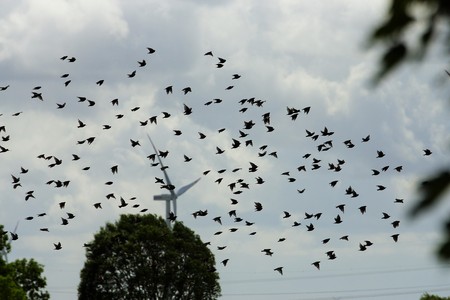The wind cult works overtime to avoid the bloody reality that their beloveds are responsible for millions of bird and bat deaths, every year. Lying, dissembling and attempting to bury the evidence is just the start. There follows a game of moral equivalence, asserting that more bats and birds are clobbered by cars, cats and tall buildings.
Cars, cats and skyscrapers don’t kill healthy Eagles – like the critically endangered Tasmanian wedge-tailed eagle, but 60 m wind turbine blades with their tips travelling at 350 Kph routinely smash them out of existence.
As part of the same race to the periphery, wind worshippers also spin the line that evil fossil fuels are responsible for even more avian carnage. Except, as James Taylor points out below those claims ring just a little hollow.
Wind apologists laughably claim fracking harms wildlife
CFACT
James Taylor
3 November 2019
Apologists for wind power, which kills literally millions of birds and bats each year, are ramping up a public relations campaign to mislead people into believing fracking disproportionately harms wildlife. Given the deadly impact of wind turbines, wind power apologists would be wise to never mention the topic of energy and wildlife deaths.
Peer-reviewed research (https://wildlife.onlinelibrary.wiley.com/doi/abs/10.1002/wsb.260) has determined wind turbines kill 1.4 million birds and bats each year throughout the United States, even with wind power producing just a few percent of American electricity. Many of the birds and bats killed are threatened or protected species.
Ramping up wind power to the approximately 80 percent of American electricity currently produced by natural gas, coal, and hydro power would accordingly kill approximately 20 million birds and bats each year.
Nevertheless, the website EcoWatch recently posted an article titled, “We’re Just Starting to Learn How Fracking Harms Wildlife.” (https://www.ecowatch.com/how-fracking-harms-wildlife-2640821015.html?rebelltitem=1#rebelltitem1) The article appeared prominently near the top of a Google News search for “fracking.”
The article provides anecdotes of two pipeline spills of fracking solution during the past 15 years. The article does not provide any numbers of wildlife deaths resulting from the spills – probably because fracking solution is 90 percent water and 9 percent sand. (https://www.chemservice.com/news/2014/06/chemicals-and-fracking-what-makes-up-fracking-fluid/)
Water and sand don’t kill animals.
Next, the article asserts, “the most obvious threats fracking poses to wildlife comes in the form of habitat loss.” The article laments that “the cumulative footprint for a single new [fracking] well can be as large as 30 acres.” The article conveniently fails to mention that 300 square miles of wind turbines are necessary to replace even a single conventional power plant. (https://www.nei.org/news/2015/land-needs-for-wind-solar-dwarf-nuclear-plants) If land preservation is an important environmental consideration – and it should be – wind power is exponentially worse for the environment than conventional energy.
The article claims pipelines and roads that service well sites create “another kind of fragmentation.” The article conveniently fails to mention that wind and solar facilities are typically located far away from human population centers, often requiring the construction of hundreds or thousands of miles of new transmission lines to bring power to its market. Conventional power plants, however, are typically places quite close to the population centers they service. All the wind and solar power transmission lines fragment natural ecosystems far more than conventional power production.
In short, wind and solar apologists live in glass houses yet insist on throwing stones at conventional energy. If central issues in the energy and environment debate are impacts on wildlife and land conservation, that is a discussion wind and solar apologists would be wise to avoid.
CFACT



Reblogged this on ajmarciniak.
Reblogged this on Gds44's Blog.
Reblogged this on ECO-ENERGY DATABASE.
Reblogged this on Climate- Science.press.